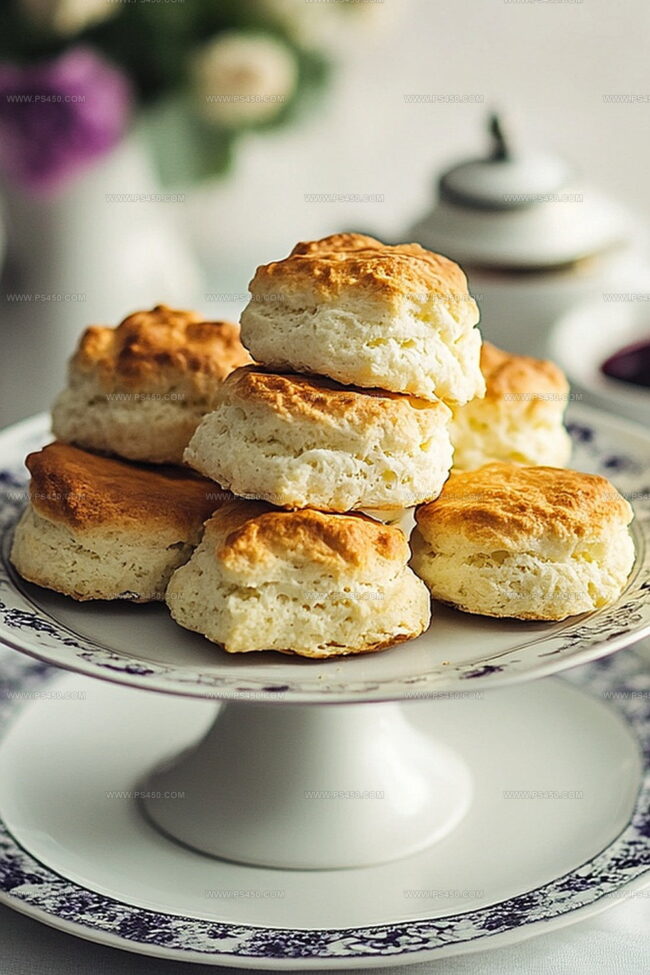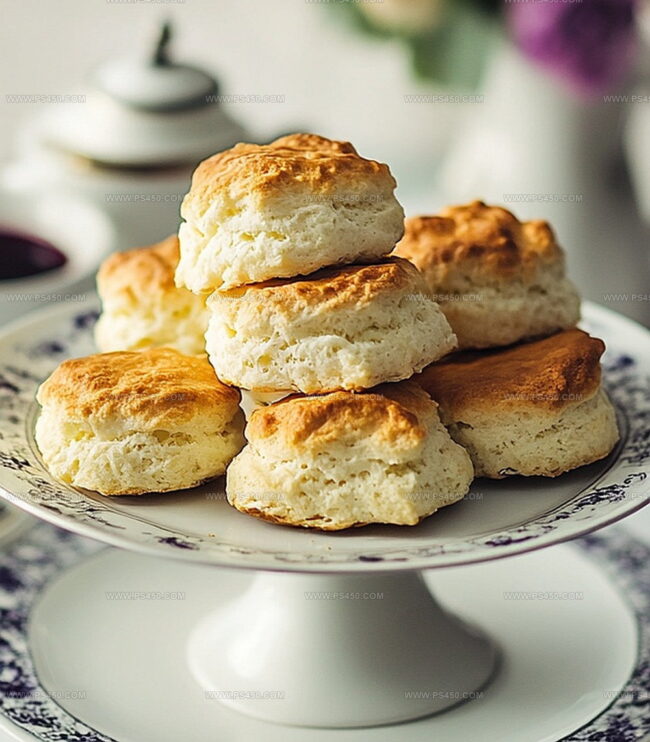Sweet Homemade Irish Scones Recipe: The Coziest Breakfast Treat
Light and buttery irish scones have been my weekend breakfast obsession lately.
Crisp mornings call for warm, comforting treats straight from the oven.
My grandmother taught me this cherished recipe during childhood visits to her cozy kitchen.
Soft interior crumbles perfectly against a delicate golden-brown exterior that hints at deliciousness.
Baking these simple delights requires minimal ingredients but delivers maximum satisfaction.
Sweet or savory variations make these scones incredibly versatile for any meal.
You’ll want to share these delectable morsels with everyone around the table.
Let’s whip up a batch that promises to become your new favorite morning ritual.
Why Irish Scones Are Buttery, Soft, And Easy To Love
What You Need To Bake Irish Scones At Home
Dry Ingredients:Wet Ingredients:Optional Add-Ins:Finishing Touch:Step-By-Step Guide To Irish Scones
Step 1: Warm Up the Oven
Set your oven to 400°F (200°C). Cover a baking sheet with parchment paper to prevent sticking.
Step 2: Blend Dry Ingredients
Grab a large mixing bowl and combine:Mix these dry ingredients until well blended.
Step 3: Incorporate Butter
Take cold butter and cut it into small cubes. Add to the flour mixture. Use your fingertips or a pastry cutter to break down the butter until the mixture looks like rough sand or breadcrumbs.
Step 4: Introduce Liquid Ingredients
In a separate bowl, whisk together:Create a small well in the center of your dry ingredients. Pour the liquid mixture into this well. Gently stir until a soft, slightly sticky dough forms.
Step 5: Add Sweet Surprises
If you want extra flavor, fold in:Mix these gently to distribute evenly throughout the dough.
Step 6: Shape the Dough
Dust a clean surface with flour. Transfer the dough and knead softly for about 1-2 minutes. Pat the dough into a circular shape approximately 1-inch thick.
Step 7: Create Perfect Scones
Use a round biscuit cutter to shape your scones. Press firmly and lift straight up to create clean edges. Place each scone on the prepared baking sheet. Collect remaining dough scraps, reshape, and cut additional scones.
Step 8: Final Touch and Baking
Brush the tops of the scones with an egg wash to create a beautiful golden crust. Slide the baking sheet into the preheated oven. Bake for 15-20 minutes until the scones turn a gorgeous golden brown color.
Serve warm with clotted cream, butter, or your favorite jam. Enjoy your homemade Irish scones!
Tips For Perfectly Fluffy Irish Scones
How To Store Irish Scones Without Drying Them Out
What To Pair With Irish Scones
Flavors To Try In Your Irish Scones
Common Questions About Irish Scones
Irish scones are typically less sweet and more dense compared to English or American versions. They’re made with minimal sugar and often include simple ingredients, focusing on a hearty, traditional texture that pairs perfectly with tea or jam.
Absolutely! These scones are versatile. You can skip the raisins entirely or substitute them with other mix-ins like dried cranberries, chocolate chips, or nuts depending on your preference. The base recipe works wonderfully with or without additional ingredients.
Look for a golden-brown color on the top and bottom of the scones. They should be firm to the touch but not hard. When you tap the bottom of a scone, it should sound slightly hollow, indicating they’re fully baked.
Cold butter is crucial because it creates small, solid pockets in the dough that melt during baking, producing those signature flaky layers. When you cut the cold butter into the flour, it helps create a tender, light texture in your scones.
Print
Irish Scones Recipe
- Total Time: 35 minutes
- Yield: 12 1x
Description
Warm Irish scones bring comfort straight from Ireland’s hearty kitchens. Rich butter and delicate crumb invite you to savor pure traditional breakfast magic with each tender, golden bite.
Ingredients
Main Ingredients:
- 4 cups (480 grams) all-purpose flour
- ¾ cup (170 grams) cold unsalted butter, cut into small cubes
- 1 cup (240 milliliters) cold whole milk (or buttermilk)
- 2 large eggs, lightly beaten
- 1 cup raisins or currants (optional)
Dry Ingredients:
- ¼ cup (50 grams) granulated sugar
- 2 tablespoons baking powder
- ½ teaspoon salt
Egg Wash:
- 1 egg, beaten with 1 tablespoon milk
Instructions
- Prepare the baking environment by heating the oven to 400F (200C) and lining a baking sheet with parchment paper, ensuring an even cooking surface.
- Create a foundation for the scones by thoroughly blending flour, sugar, baking powder, and salt in a spacious mixing vessel, establishing a uniform dry mixture.
- Incorporate cold, cubed butter into the dry ingredients, methodically breaking down the butter using a pastry cutter or fingertips until the texture resembles coarse, sandy granules.
- Whisk milk and eggs in a separate container, forming a smooth liquid base. Create a central depression in the dry ingredients and carefully pour the wet mixture, gently combining until a soft, cohesive dough emerges.
- If desired, delicately integrate raisins or currants throughout the dough, distributing them evenly to ensure consistent flavor in each scone.
- Transfer the dough onto a lightly floured workspace, tenderly kneading for 1-2 minutes to achieve a smooth consistency. Shape the dough into a uniform circular form approximately one inch thick.
- Utilize a round biscuit cutter to precisely extract individual scones from the dough. Arrange the cut pieces on the prepared baking sheet, reassembling and cutting any remaining dough fragments.
- Apply an egg wash to the scone surfaces, creating a lustrous, golden-brown exterior. Bake for 15-20 minutes until the scones achieve a rich, warm coloration and a perfectly crisp finish.
Notes
- Chill your butter thoroughly before mixing to ensure flaky, tender scones with perfect texture.
- Use cold ingredients like milk and eggs straight from the refrigerator to maintain dough’s optimal consistency and promote better rising.
- Avoid overmixing the dough, which can develop gluten and make scones tough instead of light and crumbly.
- Experiment with flavor variations by substituting raisins with chocolate chips, dried cranberries, or chopped nuts for different taste profiles.
- Prep Time: 15 minutes
- Cook Time: 20 minutes
- Category: Breakfast, Snacks, Desserts
- Method: Baking
- Cuisine: Irish
Nutrition
- Serving Size: 12
- Calories: 200
- Sugar: 3.5 g
- Sodium: 0.1 g
- Fat: 8 g
- Saturated Fat: 5 g
- Unsaturated Fat: 2 g
- Trans Fat: 0 g
- Carbohydrates: 30 g
- Fiber: 1 g
- Protein: 4 g
- Cholesterol: 50 mg




Emily Morgan
Food Critic & Kitchen Tips Specialist
Expertise
Global Food Exploration & Critique, Simple Kitchen Hacks & Time-Saving Tips, Presentation & Plating Techniques, Culinary Research & Storytelling.
Education
New York University
Emily Morgan has journeyed across the globe, collecting culinary secrets that turn everyday ingredients into impressive meals.
Based in Seattle and armed with a Journalism degree from NYU, she blends thorough research with a flair for presentation, ensuring every dish looks just as good as it tastes.
Focusing on fresh flavors, simple methods, and a bit of fun, Emily shows home cooks how to elevate their daily cooking without fancy gadgets or complex steps.